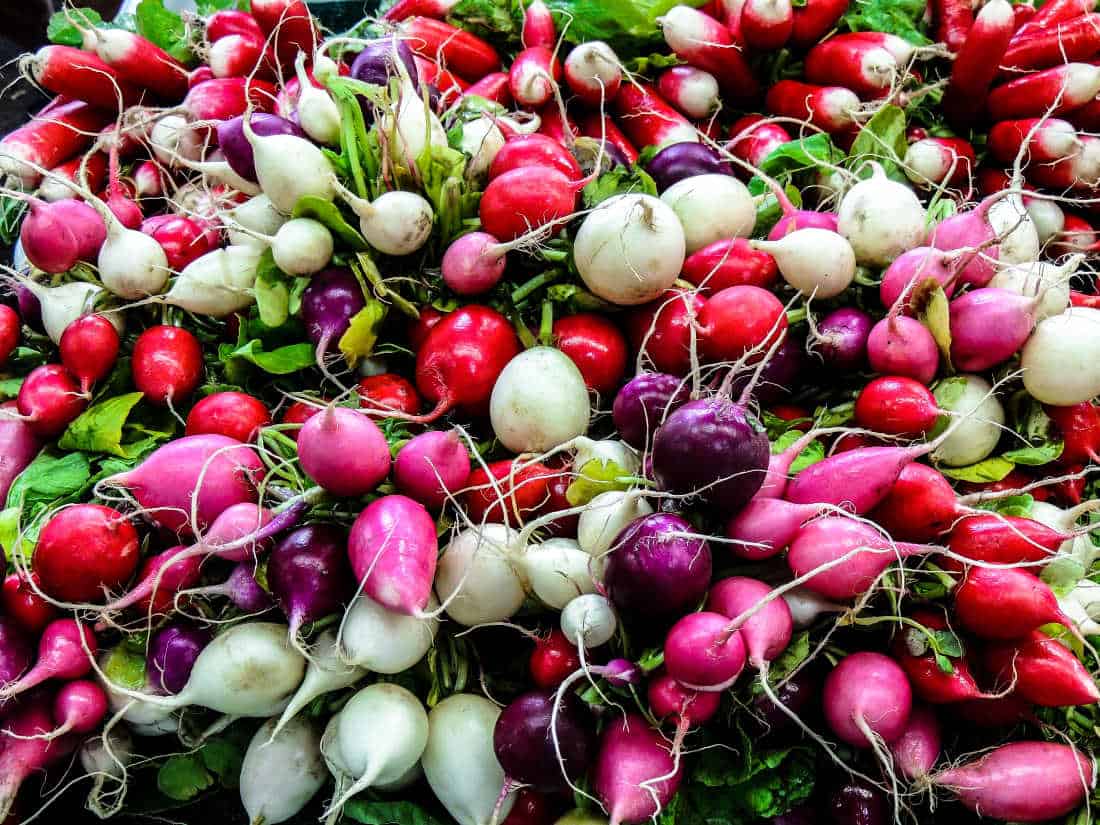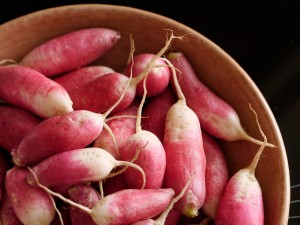What types of radishes can you grow in the home garden? If you live in gardening zones 3 through 9 in the United States you can grow almost any radishes!
Some people love radishes, while others hate them. I’m sort of in the middle. The first radish of spring picked fresh from the garden is a welcome bitter taste to cleanse the palate. After a few weeks of radishes, I’m finished for the year and glad to turn the radish section of the garden over to another less pungent vegetable.
However, they make great salads. Cucumber-Radish Salad and Garden Radish Salad are two favorites.
The following article includes affiliate links. We are a participant in the Amazon Services LLC Associates Program, an affiliate advertising program designed to provide a means for us to earn fees by linking to Amazon.com and affiliated sites. Thank you so much for being a part of Home Garden Joy!

History of Radishes
Radishes are an old, old vegetable. They were grown throughout Europe before the Romans arrived. They grew in the colder Northern European climates, and some types stored well through the cold winter. They’ve very nutritious and add flavor and seasoning to many dishes. There’s a history of radishes tracing back to ancient India, Asia, and Japan. Wild radishes probably come from Asia. They’re related to the brassica family of vegetables, so they’re cousins, so to speak, of cabbages and other sharp-tasting, strong-smelling, cold weather good-for-you crops.
Why Grow Radishes?
- Radishes are one of the easiest vegetables to grow in the home garden. They’re also a great first garden project for kids because they grow so quickly; you can keep a child’s interest more easily when their gardening project grows rapidly.
- Radishes are also very versatile. They’re used in salads and for fresh vegetables, to be sure. Recent agricultural research also recommends planting radishes as a cover crop to improve soils.
For those new to growing vegetables at home, radishes are a great first vegetable to try. Purchase your seeds now in early spring, since radishes are a cool-weather crop. If you wait too long to plant them, they’ll mature when it’s warm, and the warmer it is outside, the hotter the radish. If you like eating live firecrackers, try eating a radish grown in the summertime. Yowza!
Types of Radishes to Grow in the Home Garden
Radishes are best started directly from seeds sown into the garden soil, so look to the seed racks at your local garden center when you want to find the best types of radishes to grow in the home garden. Catalogs and heirloom seed companies, like Baker Creek Seeds and The Cook’s Garden, offer many choices of radish varieties that are hard to find in most chain stores.
Although the radishes you can purchase at the supermarket all feature round, red globes the size of quarters on the end of scratch green stems, radishes come in a range of sizes, colors, shapes and flavors.
- Round roots: The most popular are the round-root types, with either red or white roots. Cherry Belle and Early Scarlet Globe are popular red-rounded root types. For a white radish, try Helios. If you’re feeling very adventurous, there’s the Chinese Red Meat radish, which has a red bulls-eye center and white surrounding the radish.
- Icicle types: Icicle radishes have long, slender roots similar to carrots but not as big. I’ve grown some of these including the “French Breakfast” radish and found the taste is milder. They seem to be a little more susceptible to carrot fly and other pests that attack root crops, but the milder taste appeals to me. Try French Breakfast or Long Scarlet.
- Winter radish: Winter radishes are sown in the fall and store for long periods of time. Try the unusual Black Spanish for a winter radish. Yes, the outside of the radish is black, but the interior is white. Wouldn’t that look pretty in a salad? April Cross and Omry are other winter radish types to try.
Growing Radishes
You can grow radishes in window boxes, containers or garden soil. They need fertile, loamy soil, so amend the soil with plenty of compost. Plant a row of radish seeds, with the seeds spaced about two inches apart. Plant the seeds about an inch down into the soil or so. Water well, and continue watering as needed.
Sow Seeds Directly into the Soil
Sow seeds in rows about six to eight inches apart. I like to sow radish seeds in two-week intervals. Like lettuce, this staggers the harvest so that there’s a continual supply of vegetables coming in rather than a huge harvest all at once.
Harvesting
Harvest radishes in about 21 to 30 days after germination. I usually pull a test radish from the end of the row or dig down with my fingers to feel the size of the radish before pulling it. Wash it, slice it and enjoy it! Compost the green tops and stems and you’ve got a lovely little veggie to enjoy.
Cool Weather Crop
Once the weather turns warmer in mid-spring, stop planting radish. As I mentioned earlier, the hot weather causes radishes to turn very bitter indeed. Once the root splits, it’s inedible although some may disagree with me on this. I’ve found that split roots, overgrown radishes, and radishes that are grown in the hot weather taste terrible, so I just compost them and make a mental note to not let them go so long next time.
I hope you give radishes a try in your garden this year. You’ll be amazed at the difference in taste between the little plastic packages of radishes from the produce aisle and a fresh one plucked from the garden!
Types of Radishes to Try
David’s Garden Seeds Radish Easter Egg SL8456 (Multi) 500 Non-GMO, Open Pollinated Seeds


French Breakfast Radish Seeds, 200+ Premium Quality Heirloom Seeds, Popular & Delicious!, On Sale, (Isla’s Garden Seeds), Non GMO, 85-90% Germination Rates, Highest Quality Seeds, 100% Pure
Radish Recipes
- Bon Appetit has a great article on using radishes in various dishes.
- Real Simple offers 13 radish recipes.
- Cooking Light provides 20 radish recipes.







I happen to be in the “I LOVE radishes” camp! 🙂 Sadly, I’m the only one in my immediate family who likes them. I did not know that the hotter the weather, the hotter the radish. I love hot, so I may try my hand at planting them a little late. Those black radishes are so pretty. My parents always planted the regular red ones, but I like how you showcased all the different varieties.
Thanks Alli! Yes, hot weather turns them into firecrackers. Not for me…I’ll take mild!
Okay, this is how in the dark I am – I had no idea there were TYPES of radishes. So thank you for this post!!!
We’re not big radish eaters here. I plan on starting another garden this year and since these are easy to grow I may just have to incorporate more of it into our diet.
I love radishes too, but I am like you. I prefer them mild. I am thinking about starting some in container this weekend and some onions too.
I like raw and fermented radishes. I have a jar of fermented ones in my fridge right now.
I had no idea there were so many varieties of radishes. I am going to have to look into that! Variety is the spice of life.
We are really not big radish eaters at our house. I will eat them on a salad but I don’t search them out. Maybe if we planted some, we might be more inclined to eat more. Pinned this to my Yard and Garden board, maybe we will plant some.
Those are some good looking radishes. The Spanish Black Radish looks very interesting! I planted our first radishes in the greenhouse, look forward to some yumyness ;).